
Match the items in the left column with the items in the right column
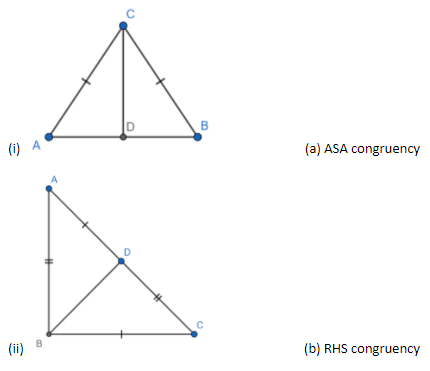
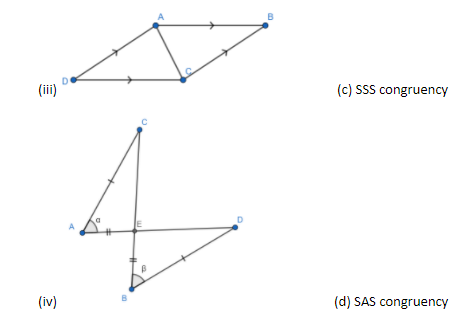
$\begin{align}
& [a]\left( i \right)\to \left( b \right),\left( ii \right)\to \left( d \right),\left( iii \right)\to \left( a \right),\left( iv \right)\to \left( c \right) \\
& [b]\left( i \right)\to \left( c \right),\left( ii \right)\to \left( a \right),\left( iii \right)\to \left( b \right),\left( iv \right)\to \left( d \right) \\
& [c]\left( i \right)\to \left( b \right),\left( ii \right)\to \left( c \right),\left( iii \right)\to \left( a \right),\left( iv \right)\to \left( d \right) \\
& [d]\left( i \right)\to \left( a \right),\left( ii \right)\to \left( c \right),\left( iii \right)\to \left( b \right),\left( iv \right)\to \left( d \right) \\
\end{align}$


Answer
565.5k+ views
Hint: Recall the various criteria for congruence and identify which rule should be applied to which example. Hence determine which example matches to which rule.
Complete step-by-step answer:
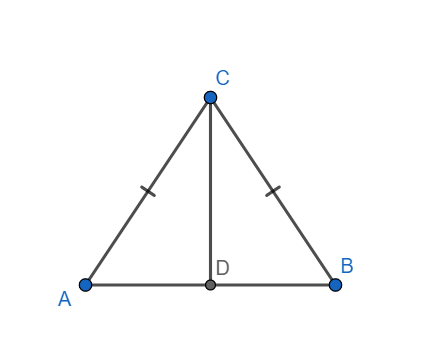
In triangles ACD and BCD, we have
AC = BC (Given)
$\angle CDA=\angle CDB$ (each 90)
CD = CD.
Hence we have $\Delta ADC\cong \Delta BDC$ by RHS congruence criterion.
Hence $\left( i \right)\to \left( b \right)$
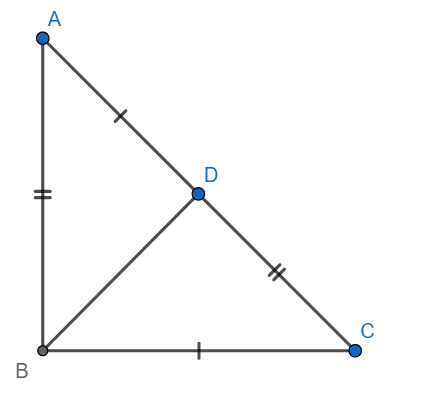
In triangles ABD and CDB, we have
AB = CD (Given)
AD = BC (Give)
BD = BD (Common side)
Hence $\Delta ABD\cong \Delta CDB$ by SSS congruence criterion.
Hence $\left( ii \right)\to \left( c \right)$
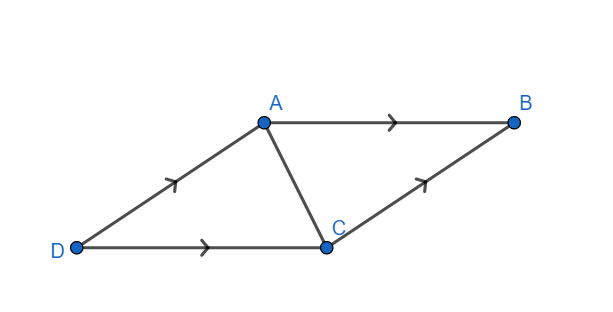
Since $AB\parallel DC,$ we have $\angle ACD=\angle CAB$ (alternate interior angles)
Similarly, since $AD\parallel CB,$ we have $\angle DAC=\angle ACB$
In triangles ADC and CBA, we have
$\angle ACD=\angle CAB$ (proved above)
AC = AC (common side)
$\angle DAC=\angle ACB$ (proved above)
Hence $\Delta ACD\cong \Delta CAB$ by ASA congruence criterion.
Hence $\left( iii \right)\to \left( a \right)$

In triangles AEC and BED, we have
AC = BD (Given)
$\angle CAE=\angle EBD$ (Given)
AE = BE (Given)
Hence $\Delta AEC\cong \Delta BED$ by SAS congruence criterion
Hence $\left( iv \right)\to \left( d \right)$
So, the correct answer is “Option (c)”.
Note: In these types of questions, we need to think that what is given in the diagram and what can be derived. Hence we must understand which congruence rule should we apply to prove the triangles congruent. Also, we need to understand what various congruence criteria mean. Like SAS congruence condition is valid when the angle is the angle included between the two sides. Many students fail to realise that and hence prove triangles are congruent in an incorrect way.
Complete step-by-step answer:

In triangles ACD and BCD, we have
AC = BC (Given)
$\angle CDA=\angle CDB$ (each 90)
CD = CD.
Hence we have $\Delta ADC\cong \Delta BDC$ by RHS congruence criterion.
Hence $\left( i \right)\to \left( b \right)$

In triangles ABD and CDB, we have
AB = CD (Given)
AD = BC (Give)
BD = BD (Common side)
Hence $\Delta ABD\cong \Delta CDB$ by SSS congruence criterion.
Hence $\left( ii \right)\to \left( c \right)$

Since $AB\parallel DC,$ we have $\angle ACD=\angle CAB$ (alternate interior angles)
Similarly, since $AD\parallel CB,$ we have $\angle DAC=\angle ACB$
In triangles ADC and CBA, we have
$\angle ACD=\angle CAB$ (proved above)
AC = AC (common side)
$\angle DAC=\angle ACB$ (proved above)
Hence $\Delta ACD\cong \Delta CAB$ by ASA congruence criterion.
Hence $\left( iii \right)\to \left( a \right)$

In triangles AEC and BED, we have
AC = BD (Given)
$\angle CAE=\angle EBD$ (Given)
AE = BE (Given)
Hence $\Delta AEC\cong \Delta BED$ by SAS congruence criterion
Hence $\left( iv \right)\to \left( d \right)$
So, the correct answer is “Option (c)”.
Note: In these types of questions, we need to think that what is given in the diagram and what can be derived. Hence we must understand which congruence rule should we apply to prove the triangles congruent. Also, we need to understand what various congruence criteria mean. Like SAS congruence condition is valid when the angle is the angle included between the two sides. Many students fail to realise that and hence prove triangles are congruent in an incorrect way.
Recently Updated Pages
Master Class 12 Economics: Engaging Questions & Answers for Success

Master Class 12 Maths: Engaging Questions & Answers for Success

Master Class 12 Biology: Engaging Questions & Answers for Success

Master Class 12 Physics: Engaging Questions & Answers for Success

Master Class 8 Maths: Engaging Questions & Answers for Success

Class 8 Question and Answer - Your Ultimate Solutions Guide

Trending doubts
Why is there a time difference of about 5 hours between class 10 social science CBSE

Write a letter to the principal requesting him to grant class 10 english CBSE

What is the median of the first 10 natural numbers class 10 maths CBSE

The Equation xxx + 2 is Satisfied when x is Equal to Class 10 Maths

Which of the following does not have a fundamental class 10 physics CBSE

State and prove converse of BPT Basic Proportionality class 10 maths CBSE




